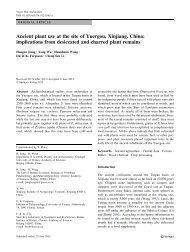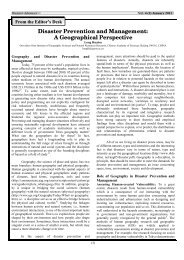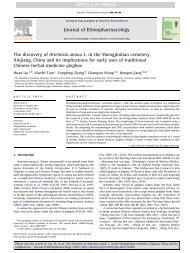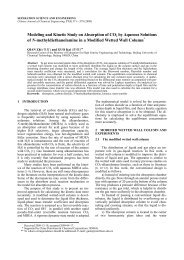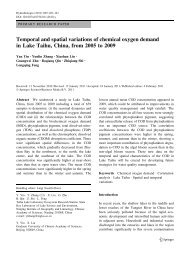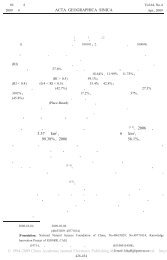THE 1920S DROUGHT RECORDED BY TREE RINGS AND ...
THE 1920S DROUGHT RECORDED BY TREE RINGS AND ...
THE 1920S DROUGHT RECORDED BY TREE RINGS AND ...
You also want an ePaper? Increase the reach of your titles
YUMPU automatically turns print PDFs into web optimized ePapers that Google loves.
426 ERYUAN LIANG ET AL.TABLE VThe historical records about the 1920s droughtYear Historical record Source1928 In Shaanxi, Ningxia and Gansu, the summer grain only has20–30% of the average annual yield and the autumn grain hadno harvest at all in 1928.The winter wheat could not be sown because of the persistentdrought. The corn price was 5 times higher than normal in thewinter of 1928.The extraordinary drought in 1928 also caused a heavy mortalityof old trees in Shaanxi and Gansu.No precipitation during the spring and summer in 1928 inwestern Inner Mongolia; no grass could survive in thegrassland region, leading to a substantial loss of livestock.Since 1925, Chihli, including eastern Inner Mongolia andnorthern Hebei Provinces, has suffered from the drought, andthe nomadic area in Xilin Gol Banner lost most livestock.As a consequence of the repeated crop failures in Shaanxi,Ningxia, Gansu, Inner Mongolia, the overwhelming majorityof the population had to live on an unwholesome diet,including grasses and their roots, tree bark, and chaff. Theeating of grass and tree bark mixed with ground clay resultedin sickness and usually hastened death.1929 There were 2.21 million victims of drought calamity in fourteencounties including Guanzhong, Weinan, Pucheng, Huaxian andLintong, et al., in Shaanxi by the end of January 1929; grainstorage was only about 12.5 million kg. Thus, each person inthese counties had only an average of six kg of grain in a year.No single grain was harvested among all the 88 counties ofShaanxi Province in the summer and autumn of 1929.In the worst affected area in Gansu, Ningxia and Shaanxi, thechaff, seeds and roots of grasses and tree bark were notavailable in 1929. Most livestock starved to death and wereeaten. About 70% of the trees have been killed throughanthropogenic removal of tree bark and leaves.Severe hunger has led to some cases of cannibalism in Shaanxiand Gansu Provinces.In Shaanxi, three million perished from starvation, disease andviolence and six million people became utterly destitute andhomeless, which accounted for 70% of the entire population(13 million).Out of a population of 5.5 million, 4.57 million were affected bythe famine in Gansu. The death of people in Gansu was about2.3 million, of which 1.4 million people perished of starvation,0.6 million died of epidemics and 0.3 million lost their lives inthe violence.Ningxia Province lost one third of its entire population (0.7million).Takung Newspaper,September 21 1928;Shanghai Daily, June 26,1929Summary documents ofdisaster relief, 1928Takung Newspaper, July16Takung Newspaper, July14, 1929Takung Newspaper onJuly 16 and September8, 1928The report of “Lvpingassociation for disasterrelief in Shaanxi” inFebruary 1929Summary documents offamine relief inShaanxi, 1932Takung NewspaperFebruary 15, May 6,1929 Takung,Newspaper, May 61929Shanghai Daily, April28, 1929 and March16, 1931Guowen WeeklyNewspaper, 7 (19),page 8Summary documents ofdisasters in eachcounty of Gansu in1929Deng, 1937



